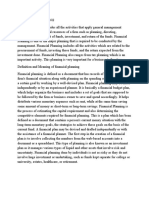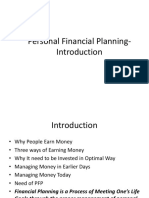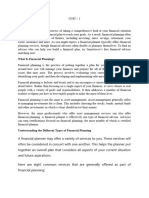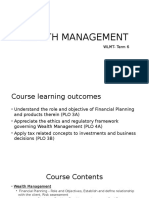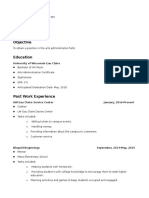Chapter 1: Introduction to Personal Financial Planning - Comprehensive Notes
1. Defining Financial Planning and its Scope
• Financial Planning: This is a comprehensive process where an adviser helps a
client articulate their life goals and then creates a detailed, actionable plan to
achieve them. It is a long-term, holistic approach that considers all aspects of a
client's financial life.
• Investment Advice: This is a key component within the broader financial
planning process. It specifically involves providing advice on investing in, buying,
selling, or dealing with securities or investment products.
• Scope: The process covers managing income and expenses, savings and
investments, insurance, retirement planning, and estate planning to ensure
financial well-being at every stage of life.
2. The Need for Financial Planning
The modern financial landscape has introduced new complexities and responsibilities
for individuals, making professional financial planning more critical than ever.
• Shift from Defined Benefit to Defined Contribution: In the past, many
employees had "defined benefit" pensions, where the employer guaranteed a
fixed retirement income. Today, the system has shifted to "defined contribution"
plans (like provident funds and NPS). This places the responsibility of building a
sufficient retirement corpus directly on the individual, making planning
essential.
• Decline in Interest Rates: Falling interest rates on traditional safe investments
like bank fixed deposits mean that investors must create a structured investment
plan to generate returns that can outpace inflation.
• Increased Lifespan: People are living longer, which means retirement funds
need to last for a much longer period, requiring more careful and strategic
planning.
• Availability of Complex Products: The market is filled with a wide array of
complex financial products, making it difficult for the average person to choose
the right ones without professional guidance.
3. Role and Responsibilities of a Financial Planner
A financial planner (or Investment Adviser) is a professional who guides clients through
the financial planning process for a fee. Their primary responsibility is to understand the
client's comprehensive needs and recommend suitable strategies.
• Key Responsibilities:
� 1. Understand the Client: Gather detailed personal and financial
information.
2. Risk Profiling: Assess the client's willingness and ability to take risks.
3. Asset Allocation: Recommend a suitable mix of asset classes (equity,
debt, etc.) based on the client's profile and goals.
4. Product Selection: Help select specific investment products that align
with the asset allocation strategy.
5. Implementation and Review: Assist in executing the plan and
periodically review the portfolio to ensure it remains on track with life
changes and market conditions.
4. Steps in the Financial Planning Process
The process of providing financial advice is structured and systematic.
1. Establishing the Client-Planner Relationship: Clearly define the scope of the
engagement and the responsibilities of both parties.
2. Gathering Client Data and Goal Setting: Collect comprehensive quantitative
(income, assets) and qualitative (values, attitudes) information. Help the client
define specific, measurable, achievable, relevant, and time-bound (SMART)
financial goals.
3. Analyzing Financial Situation and Risk Profiling: Analyze the client's cash flow,
net worth, and assess their risk tolerance.
4. Developing the Financial Plan: Create a detailed plan with specific
recommendations for asset allocation, insurance, retirement planning, etc.
5. Implementing the Plan: Put the plan into action by making the recommended
investments and purchasing necessary products.
6. Monitoring and Reviewing the Plan: Regularly review the plan's progress and
the client's situation, and make adjustments as needed. This is a crucial,
ongoing step.
5. Understanding the Client: KYC and Risk Profiling
• Know Your Client (KYC): A mandatory regulatory process to verify the client's
identity, address, and financial status.
• Risk Profiling: A critical step to understand the client's attitude towards risk. It
involves assessing:
� o Risk Required: The level of risk that must be taken to achieve the client's
financial goals.
o Risk Capacity: The client's ability to take financial risks without
jeopardizing their financial stability.
o Risk Tolerance: The client's psychological willingness to take risks.
o Guideline: The final risk profile used for recommendations should be the
lowest of these three factors to ensure client safety.
6. Business Models for Financial Planners
• Individual Financial Planner/IA: A professional who provides advice on an
individual basis.
• Corporate Body: An advisory firm structured as a company or LLP.
• Support Services:
o Distributors and Agents: While IAs cannot distribute products
themselves, they may work alongside distributors who execute the
transactions based on the adviser's recommendations.
o Aggregators: Firms that provide support services like research, training,
and technology platforms to individual advisers.
o Wraps and Platforms: Technology-based solutions that offer
standardized model portfolios and execution services, which IAs can use
to manage client investments efficiently.
